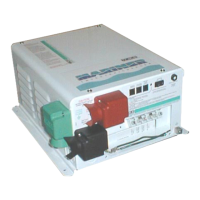$33/,&$7,216
&RS\ULJKW7UDFH(QJLQHHULQJ&R,QF 7HOHSKRQH 3DUW1XPEHU
WK
6WUHHW1( )D[ 2FWREHU
$UOLQJWRQ:$86$ ZZZWUDFHHQJLQHHULQJFRP 3DJH
$SSOLFDWLRQV
AC loads on the inverter differ in the way they perform. There are different types of loads: resistive
loads, inductive loads, and problem loads
.
5 HVLVWLYH/RDGV
These are the loads that the inverter finds the simplest and most efficient to drive. Voltage and
current are in phase, or, in this case, in step with one another. Resistive loads usually generate heat
in order to accomplish their tasks. Toasters, coffee pots and incandescent lights are typical resistive
loads. Larger resistive loads—such as electric stoves and water heaters—are usually impractical to
run off an inverter due to their high current requirements. Even though the inverter can most likely
accommodate the load, the size of battery bank required would be impractical.
,QGXFWLY H/RDGV
Any device that has a coil of wire in it probably has an inductive load characteristic. Most electronics
have transformers (TV’s, stereos, etc.) and are therefore inductive. Typically, the most inductive
loads are motors. The most difficult load for the inverter to drive will be the largest motor it manages
to start. With inductive loads, the rise in voltage applied to the load is not accompanied by a
simultaneous rise in current. The current is delayed. The length of the delay is a measure of
inductance. The current makes up for its slow start by continuing to flow after the inverter stops
delivering a voltage signal. How the inverter handles current that is delivered to it while it is
essentially “turned off”, affects its efficiency and “friendliness” with inductive loads. The best place for
this out-of-phase current is in the load. Trace’s “impulse phase correction” circuitry routes it there.
Inductive loads, by their nature, require more current to operate than a resistive load of the same
wattage rating, regardless of whether power is being supplied by an inverter, a generator, or utility
power (the grid).
Induction motors (motors without brushes) require two to six times their running current on start-up.
The most demanding are those that start under load, e.g., compressors and pumps. Of the capacitor
start motors (typical in drill presses, band saws, etc.), the largest you may expect to run is ½ to 1 hp
(depending on inverter size and surge power capability). Universal motors are generally easier to
start. Since motor characteristics vary, only testing will determine if a specific load can be started and
how long it can be run.
If a motor fails to start within a few seconds, or it begins to lose power after running for a time, it
should be turned off. When the inverter attempts to start a load that is greater than it can handle, it
will turn itself off after about 10 seconds.

